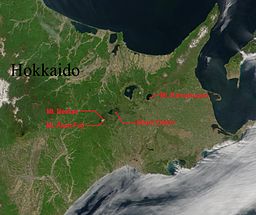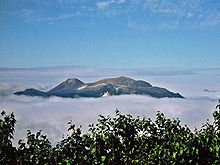- Akan Volcanic Complex
-
Akan Volcanic Complex (阿寒岳, Akan-dake) Volcanic Complex Mount Meakan, Akan-Fuji and Mount Oakan on a satellite image of Eastern HokkaidoCountry Japan State Hokkaidō Regions Kushiro Subprefecture, Tokachi Subprefecture Districts Ashoro District, Shiranuka District Municipalities Ashoro, Kushiro, Shiranuka Highest point Mount Meakan - elevation 1,499 m (4,918 ft) - coordinates 43°23′11″N 144°00′32″E / 43.38639°N 144.00889°E Geology Volcanic Orogeny island arc Akan Volcanic Complex is a volcanic group of volcanoes that grew out of the Akan caldera.[1] It is located within Akan National Park, about 50km Northwest of Kushiro in eastern Hokkaidō, Japan.
Contents
Description
A number of peaks are arranged around the rim of Lake Akan (aka Akan-ko[2]), which fills a 24x 13km caldera[3], the tallest being Me-Akan (Meakan), O-Akan (Oakan) and Akan-Fuji.[1]
 Vapor rising from Mount Meakan, seen from the lakeside of Lake Akan.
Vapor rising from Mount Meakan, seen from the lakeside of Lake Akan.
Oakan is prominently located at the Northeast side of the caldera, while Meakan occupies the opposite, Southwest side, in a cluster of nine stratovolcanoes that include Akan-Fuji, one of many symmetrical Japanese volcanoes named after the renowned Mount Fuji, and Fuppushi volcano[4] (aka Fuppushi-dake, not to be confused with Mount Fuppushi, which is located in Southwestern Hokkaido).
Volcanology
The Akan caldera was formed 31,500 years ago. Its elongated shape is due to its incremental formation during major explosive eruptions, from the early to the mid-Pleistocene periods.
The Nakamachineshiri crater of Meakan volcano was formed during a major eruption about 13,500 years ago.
The Me-Akan group of nine overlapping cones on the eastern side of Lake Akan has had mild eruptions since the beginning of the 19th century.[5] The last eruption of this historical volcano was in 2008.[3]
Oakan, Meakan, Furebetsu and Fuppushi are the major post-caldera volcanoes of the Akan volcanic complex.[1]
Me-Akan is one of the most active volcanoes of Hokkaido. Its summit contains the active craters of Ponmachineshiri and Naka-Machineshiri, sites of frequent phreatic eruptions in historical time. Akan-Fuji and O-Akan have not erupted in historical time.[4]
Akan is rated with a volcanic explosivity index of 4 on the Smithsonian VEI scale, the scale's fourth-highest score, based on the volcano's largest known eruption, around 7050 BC.[6]
Following are prominent features of Akan:[3]
Cones
- Mount Meakan (1499 m) Stratovolcano
- Akan Fuji (Akan-Fuji, aka Akan-Huji) (1476 m) Stratovolcano
- Kita-Yama (1400 m) Cone
- O-Akan (Mount Oakan) (1371 m) Stratovolcano
- Kenga-Mine Cone 1336 m
- Nishi-Yama (Nisi-Yama) (1300 m) Cone
- Fuppushi (Huppusi) (1226 m) Stratovolcano
- Miname-Dake (1217 m) Stratovolcano
- Higashi-Dake (Higasi-Dake) (1140 m) Cone
- Furebetsu (Hurebetu) (1098 m) Stratovolcano
- Kobu-Yama Cone
- Futatsu-Dake Pyroclastic cone
Craters
- Nakamachineshiri (Nakamatineshiri) Crater
- Ponmachineshiri (Ponmatinesiri) Crater
Thermal features
- Akan-Kohan Thermal Feature
Other peaks
- Mount Ken[citation needed]
- Mount Ahoro[citation needed]
References
- ^ a b c "AKAN Caldera". Quaternary Volcanoes of Japan, Geological Survey of Japan, AIST, 2006. http://riodb02.ibase.aist.go.jp/strata/VOL_JP/EN/vol/218b.htm. Retrieved 2011-03-09.
- ^ "Akan-ko: Japan". Geographical Names. http://geographic.org/geographic_names/name.php?uni=-332580&fid=3243&c=japan. Retrieved 2011-03-09.
- ^ a b c "Akan". Global Volcanism Program, Smithsonian National Museum of Natural History. http://www.volcano.si.edu/world/volcano.cfm?vnum=0805-07=. Retrieved 2011-03-09.
- ^ a b "Akan Volcanic Complex, Japan". Volcano Photos. http://www.geographic.org/photos/volcanoes/volcano_photos_91.html. Retrieved 2011-03-09.
- ^ "MEAKAN-DAKE". Quaternary Volcanoes of Japan, Geological Survey of Japan, AIST, 2006. http://riodb02.ibase.aist.go.jp/strata/VOL_JP/EN/vol/218f.htm. Retrieved 2011-03-09.
- ^ "Large Volcano Explocivity Index". Countries of the World. http://www.allcountries.org/ranks/volcano_explocivity_index_ranks.html. Retrieved 2011-03-09.
External Links
- OAKAN-DAKE, Quaternary Volcanoes of Japan, Geological Survey of Japan, AIST, 2006
Categories:- Mountains of Hokkaidō
- Volcanoes of Hokkaidō
- Mountain ranges of Japan
- Volcanic groups
Wikimedia Foundation. 2010.


